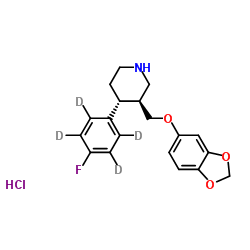rel-Paroxetine hydrochloride
Modify Date: 2024-01-14 17:29:44

rel-Paroxetine hydrochloride structure
|
Common Name | rel-Paroxetine hydrochloride | ||
|---|---|---|---|---|
| CAS Number | 1217683-35-6 | Molecular Weight | 369.851 | |
| Density | N/A | Boiling Point | N/A | |
| Molecular Formula | C19H17D4ClFNO3 | Melting Point | N/A | |
| MSDS | N/A | Flash Point | N/A | |
Use of rel-Paroxetine hydrochloriderel-Paroxetine hydrochloride is a isotope-labeled Paroxetine hydrochloride (HY-B0492). Paroxetine hydrochloride is an orally active and selective serotonin-reuptake inhibitor, commonly prescribed as an GRK2 inhibitor with IC50 of 14 μM. Paroxetine hydrochloride can be used for the research of depressive disorder[1][2][3][4]. |
| Name | (3S,4R)-3-[(1,3-Benzodioxol-5-yloxy)methyl]-4-[4-fluoro(2H4)phenyl]piperidine hydrochloride (1:1) |
|---|---|
| Synonym | More Synonyms |
| Description | rel-Paroxetine hydrochloride is a isotope-labeled Paroxetine hydrochloride (HY-B0492). Paroxetine hydrochloride is an orally active and selective serotonin-reuptake inhibitor, commonly prescribed as an GRK2 inhibitor with IC50 of 14 μM. Paroxetine hydrochloride can be used for the research of depressive disorder[1][2][3][4]. |
|---|---|
| Related Catalog | |
| Target |
IC50: 14 μM (GRK2)[2]; Serotonin-reuptake[4] |
| In Vitro | Stable heavy isotopes of hydrogen, carbon, and other elements have been incorporated into drug molecules, largely as tracers for quantitation during the drug development process. Deuteration has gained attention because of its potential to affect the pharmacokinetic and metabolic profiles of drugs[1]. Paroxetine (1 μM and 10 μM; 4 h) distinctly restrains T cell migration induced by CX3CL1 through inhibiting GRK2[2]. Paroxetine (16 h) inhibits GRK2 induced activation of ERK in splenic T cells[2]. Paroxetine (10 μM) reduces pro-inflammatory cytokines in LPS-stimulated BV2 cells[3]. Paroxetine (0-5 μM) leads to a dose-dependent inhibition on LPS-induced production of TNF-α and IL-1β in BV2 cells[3]. Paroxetine also inhibits lipopolysaccharide (LPS)-induced nitric oxide (NO) production and inducible nitric oxide synthase (iNOS) expression in BV2 cells[3]. Paroxetine (5 μM) blocks LPS-induced JNK activation and attenuates baseline ERK1/2 activity in BV2 cells[3]. Paroxetine relieves microglia-mediated neurotoxicity, and suppresses LPS-stimulated pro-inflammatory cytokines and NO in primary microglial cells[3]. |
| In Vivo | Paroxetine (15 mg/kg/d; p.o.; 15 d) obviously attenuates the symptoms of collagen-induced arthritis (CIA) rats[2]. Animal Model: Collagen-induced arthritis (CIA) model in rats (around 14-day-old)[2] Dosage: 15 mg/kg Administration: Oral gavage; once daily; 15 days Result: Helped CIA rats to restore more body weight. |
| Molecular Formula | C19H17D4ClFNO3 |
|---|---|
| Molecular Weight | 369.851 |
| Exact Mass | 369.144501 |
| (3S,4R)-3-[(1,3-Benzodioxol-5-yloxy)methyl]-4-[4-fluoro(2H4)phenyl]piperidine hydrochloride (1:1) |
| Piperidine, 3-[(1,3-benzodioxol-5-yloxy)methyl]-4-(4-fluorophenyl-2,3,5,6-d4)-, (3S,4R)-, hydrochloride (1:1) |